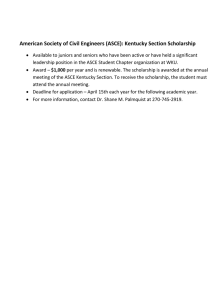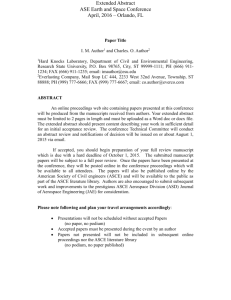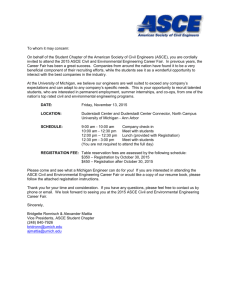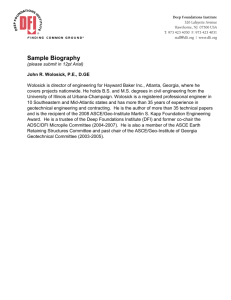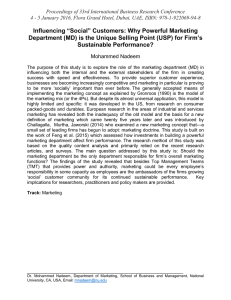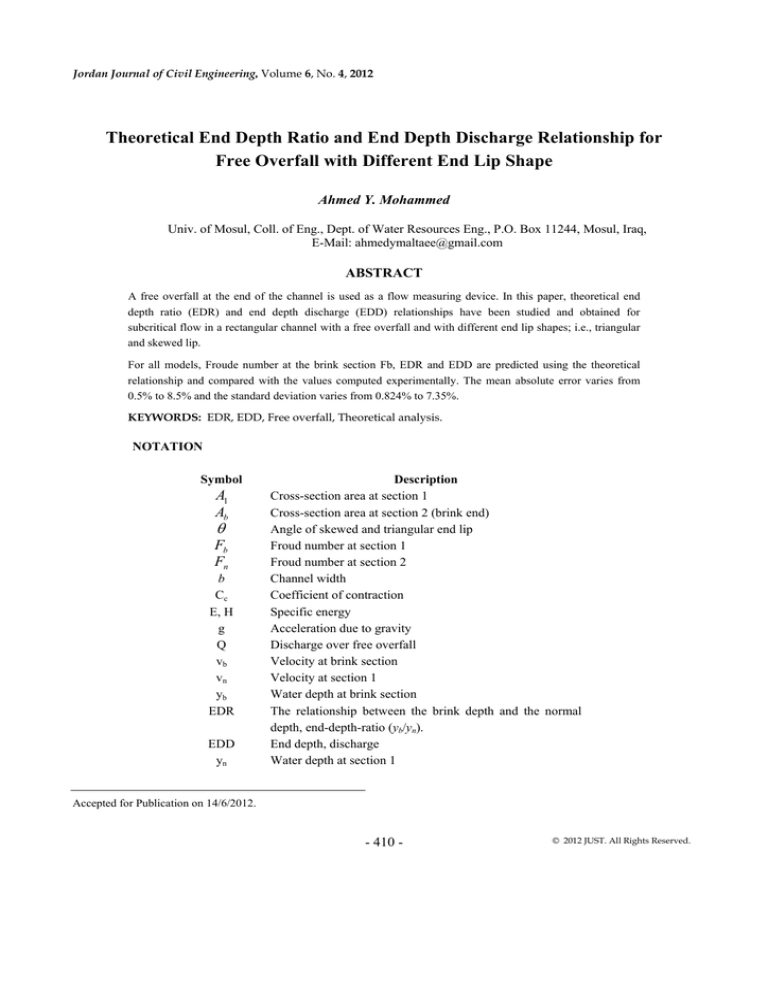
Jordan Journal of Civil Engineering, Volume 6, No. 4, 2012
Theoretical End Depth Ratio and End Depth Discharge Relationship for
Free Overfall with Different End Lip Shape
Ahmed Y. Mohammed
Univ. of Mosul, Coll. of Eng., Dept. of Water Resources Eng., P.O. Box 11244, Mosul, Iraq,
E-Mail: ahmedymaltaee@gmail.com
ABSTRACT
A free overfall at the end of the channel is used as a flow measuring device. In this paper, theoretical end
depth ratio (EDR) and end depth discharge (EDD) relationships have been studied and obtained for
subcritical flow in a rectangular channel with a free overfall and with different end lip shapes; i.e., triangular
and skewed lip.
For all models, Froude number at the brink section Fb, EDR and EDD are predicted using the theoretical
relationship and compared with the values computed experimentally. The mean absolute error varies from
0.5% to 8.5% and the standard deviation varies from 0.824% to 7.35%.
KEYWORDS: EDR, EDD, Free overfall, Theoretical analysis.
NOTATION
Symbol
A1
Ab
θ
Fb
Fn
b
Cc
E, H
g
Q
vb
vn
yb
EDR
EDD
yn
Description
Cross-section area at section 1
Cross-section area at section 2 (brink end)
Angle of skewed and triangular end lip
Froud number at section 1
Froud number at section 2
Channel width
Coefficient of contraction
Specific energy
Acceleration due to gravity
Discharge over free overfall
Velocity at brink section
Velocity at section 1
Water depth at brink section
The relationship between the brink depth and the normal
depth, end-depth-ratio (yb/yn).
End depth, discharge
Water depth at section 1
Accepted for Publication on 14/6/2012.
- 410 -
© 2012 JUST. All Rights Reserved.
Jordan Journal of Civil Engineering, Volume 6, No. 4, 2012
Mohammed et al. (2007) studied two models of free
overfall: straight vertical and skewed end lip, and
found the relationship between brink and critical depth,
the discharge equations for the two models and showed
that the discharge for the skewed lip model was greater
by 13% than for the straight vertical model.
Mohammed (2008) presented an experimental study
and analysis for the effect of channel slope on straight
vertical and skew free overfall for a rectangular
channel with different slopes, and found that the
discharge over the skewed model was greater by 21%
than for the straight vertical model. Mohammed (2009)
studied the behaviour of free surface flow on a
rectangular free overfall which has a triangular shape.
The results revealed that the ratio of brink depth to
critical depth at the center line for falls inclined with
flow direction was greater by (3%) than for falls in the
opposite direction. This value increased to (27%) when
Froud number increased from (0.04-0.18). Tigrek et al.
(2008) presented an experimental study and found the
effects of the bed roughness and slope of the channel
on the brink depth.
In this paper, the flow over a free overfall in a
rectangular channel is similar to that over a sharp
crested weir; so a theoretical analysis based on (Litsa
and Evangelos, 1995; Ferro, 1999) yielded a general
end depth discharge (EDD) relationship for subcritical
flow in a rectangular channel with different end lip
shapes.
Discharges predicted using the theoretical
relationship are compared with the available
experimental data carried out by (Ahmed et al., 2007;
Mohammed, 2009).
INTRODUCTION
A free overfall occurs when there is a sudden
reduction in bed elevation of a channel causing the
flow to separate and form a free nappe. When the
approaching flow is subcritical, the flow upstream of
the free overfall becomes critical. Due to the vertical
acceleration that occurs at the brink, the pressure
distribution is no longer hydrostatic (Seyed et al.,
2011). The relationship between the brink depth (yb)
and the normal depth (yn) is known as end-depth-ratio
(EDR=yb/yn).
Several works related to free overfall since 1936
have been studied through laboratory experiments and
theoretical studies such as (Rouse, 1936). Some of
these studies dealt with fined EDR in free overfall for
different channel shapes (circular and semicircular
channels) such as (Dey, 1998; Dey, 2000; Dey, 2001;
Dy, 2002a; Dey, 2003; Dey et al., 2003; Ahmed, 2005;
Mahesh and Arun, 2006; Mohammed, 2008).
(Rajaratnam and Muralidhar, 1970; Neogy, 1972;
Keller and Fong, 1989; Terzidis and AnastasiadouPartheniou, 1990; Gupta et al., 1993; Pagliara and Viti,
1995; Ramamurthy et al., 2004) presented studies of
free overfall in trapezoidal channels. Ali and Sykes
(1972) assumed that the value of EDR varied from
0.673 to 0.798. Dey (2002b) presented a lot of
literature review studies for free overfall in different
channel shapes. A number of studies investigated
roughness effect and slope such as (Raju and Garde,
1970; Bauer and Graf, 1971; Rajaratnam et al., 1976;
Rajaratnam et al., 1977; Kraijenhoff and Dommerholt,
1977; Knight and MacDonald, 1979; Ferro, 1992;
Davis et al., 1998; Dey, 1998; Dey, 2000; Guo, 2005;
Guo et al., 2008; Tigrek et al., 2008; Mohammad et al.,
2011; Mohammad et al., 2012). A large number of
theoretical and numerical studies have been carried out
on free overfall such as (Hager, 1983; George, 1985;
Litsa and Evangelos, 1995; Abdullah and Peter, 1996;
Davis et al., 1999; Ferro, 1999; Dey, 2000; Ahmad,
2003; Guo, 2005; Ramamurthy et al., 2006; Guo et al.,
2008).
THEORETICAL ANALYSIS
According to the previous works adopted by Litsa
and Evangelos (1995) and Ferro (1999) for rectangular
free overfall, the flow over an overfall in a rectangular
channel can be assumed to be similar to the flow over a
sharp crested weir of the same section with P = 0 and h
= yn, Fig.1.
- 411 -
Theoretical End Depth…
Ahmed Y. Mohammed
At brink end section, the streamlines are
considerably inclined and curved and the pressure
distribution is not hydrostatic.
h
yn
P
yb
1
2
a
b
Figure 1: a) sharp crested weir, b) free overfall
The flow velocity is calculated by applying the
energy equation:
2
V
E = yb + b
2g
…………(1)
where
E: specific energy;
yb: water depth at brink section;
vb: velocity at brink section;
g: acceleration due to gravity.
In accordance with the theoretical procedure
applied to compute the discharge over a sharp crested
weir, a zero pressure distribution and parallel
streamlines at the brink, neglecting the contraction of
the nappe, are initially assumed.
The discharge dQ through an elementary crosssection dA at a vertical distance dz, can be computed
applying the following continuity equation:
dQ = 2 g ( H − z )dA
…………(2)
where:
H: the energy head at section 1, and can be computed
from:
H = E = yn +
Vn 2
2g
…………(3)
- 412 -
where
yn: water depth at section 1;
vn: velocity at section 1.
Under these assumptions of a zero pressure
distribution and parallel streamlines at the brink, eq. 2
could be integrated from z = 0 to z = yn.
Then, the discharge Q is computed as:
yn
∫
Q = C c 2 g ( H − z )1 / 2 b.dz
…………………(4)
0
By integrating eq. 4, the following eq. can be written:
Q=
[
2
b 2 g C c H 3 / 2 − ( H − yn ) 3 / 2
3
]
…………(5)
where
b = channel width;
Cc: coefficient of contraction, which can be calculated
as:
C c = Ab / A1 ………………………(6)
where
Cross-section area at section 1 is A1 = by n
Cross-section area at section 2 (brink end),
b
.2 , then Ab = b sec θ (Figs.2 and 3)
Ab =
2 cos θ
Jordan Journal of Civil Engineering, Volume 6, No. 4, 2012
where
θ : Angle of skewed and triangular end lip.
ybl
β
Flow
Flow
ybcl
θ
β
b
ybr
a
b
Triangular end lip with
flow direction
Triangular end lip in
opposite flow direction
Figure 2: Free overfall sketch with
triangular end lip shape (Mohammed, 2009)
θ
Flow
(a) top view
yn
Flow
yb
(b) side view
Figure 3: Free overfall sketch with
skewed end lip shape (Ahmed et al., 2007)
Q
When
So, eq. 6 can be written as:
bg
yb
sec θ
yn
Cc =
1/ 2
yn 3 / 2
= Fn , Froude number, then eq. 8
can be written as:
……………(7)
Fn =
Substituting eq. 7 into eq. 5 and multiplying by
(1/b g 1/2 yn 3/2)
⎡ H 3/ 2
⎤
2
y
H
2 b sec θ ⎢(
) −(
− 1 )3 / 2 ⎥ ……(9)
3
yn
y
y
n
⎣ n
⎦
Knowing that E = H = y +
Q
bg
1/ 2
yn
3/ 2
=
[
2 b 2 g sec θ y b
.
H 3 / 2 − ( H − y n )3 / 2
3 bg 1 / 2 y n 3 / 2 y n
]
V2
V
and F =
,
2g
gy
we can take into account that:
F 2
H
−1= n
yn
2
……………(8)
- 413 -
………………(10)
Theoretical End Depth…
Ahmed Y. Mohammed
⎛ ( F 2 + 2 )3 / 2 − Fn 3
Fb = Fn ⎜ n
⎜
3Fn
⎝
Then, we can get EDR from eq. 9 as:
EDR =
yb
3Fn cos θ
=
2
y n ( Fn + 2 )3 / 2 − Fn 3
……………(11)
3
sec1 / 2 θ ……(13)
EDD = Q = Fb bg 1 / 2 y b 3 / 2
………(14)
From eqs.(13 and 14), we can get the following
equation for calculating EDD:
2
⎞
⎟ sec 2 θ
⎟
⎠
3/ 2
From the relationship between Froud number and
discharge, the theoretical EDD can be obtained as:
By applying the continuity equation between
sections 1 and 2 for Q = V n y n = Vb y b , the following
equation can be obtained:
⎛ yn ⎞
⎛ Fb
⎜
⎟
⎜
⎜ y ⎟ =⎜F
⎝ b⎠
⎝ n
⎞
⎟
⎟
⎠
………………(12)
⎛ ( F 2 + 2 )3 / 2 − Fn 3 ⎞
⎟
Q = Fn ⎜ n
⎜
⎟
F
3
n
⎝
⎠
From eqs. (11 and 12), the equation below can be
obtained:
3/ 2
sec1 / 2 θ .b.g 1 / 2 .y b 3 / 2
………(15)
1.8
1.75
Fb
1.7
eq(13)
Ahmed et al.(2007)
Mohammed (2009)
1.65
1.6
0.7 Fn 0.8
0.9
1
Figure 4: Comparison between experimental Froude number (Fn, Fb) and eq.13
yb(cm)
0.6
6
5
4
3
2
1
0
eq(15)
Ahmed et al.(2007)
Mohammed (2009)
0
5
10
15
Q(l/s)
20
25
Figure 5: Comparison between experimental (Q, yb) and eq.15
- 414 -
Jordan Journal of Civil Engineering, Volume 6, No. 4, 2012
0.8
eq(11)
Ahmed et al.(2007)
Mohammed (2009)
yb/yn
0.7
0.6
0.5
0.4
0.6
0.7 Fn 0.8
0.9
1
Figure 6: Comparison between experimental (Fn, EDR) and eq.11
30
eq(15)
Ahmed et al.(2007)
Mohammed (2009)
Qth(l/s)
25
20
15
10
5
0
0
5
10
15
20
Qm(l/s)
Figure 7: Comparison between experimental discharge data computation and that computed using eq.15
From statistical programming (SPSS, V.17 and Excel)
the values of EDR computed using this equation have a
mean absolute error of 3.7% and a standard deviation
of 4.24%.
The discharge predicted using eq.15 is compared
with experimental data (Ahmed et al., 2007;
Mohammed, 2009) and is shown in Fig. 7. The
percentage error E% and the mean absolute error are
estimated. The accuracy of the discharge measurements
was within ±1% at low discharge while these values
increased at high discharge. The values of discharge
predicted using eq.15 have a mean absolute error of
8.5% and a standard deviation of 7.35%.
RESULTS
Fig.4 shows the agreement between experimental
data of Fn and Fb (Ahmed et al., 2007; Mohammed,
2009) and that computed using eq. 13, the values of Fb
computed using this equation have a mean absolute
error of 0.5% and a standard deviation of 0.824% .
Fig.5 shows the agreement between experimental
data of Q and yb (Ahmed et al., 2007; Mohammed,
2009) and that computed using eq. 15
Fig.6 shows the agreement between experimental
data of Fn and the EDR (Ahmed et al., 2007;
Mohammed, 2009) and that computed using eq. 11.
- 415 -
Theoretical End Depth…
Ahmed Y. Mohammed
CONCLUSIONS
In this paper, the free overfall in a rectangular
channel with different end lip shapes was investigated
as a device for flow measurements. Theoretical
equations for calculating end depth ratio, brink Froude
number and discharge for rectangular free overfall with
REFERENCES
Abdullah, K. and Peter, S. 1996. Modeling overfalls using
vertically averaged and momentum equations. J.
Hydraul. Eng., 122 (7): 397-402.
Ahmad, Z. 2003. Quasi-theoretical end depth discharges
relationship for rectangular channels. Journal of
Irrigigation and Drainage Engineering, ASCE, 129 (2):
138-141.
Ahmed, Z. 2005. Flow measurement using free overfall in
inverted semi-circular channels. Flow Measurement
and Instrumentation, 16 (10): 21-26.
Ali, K. H. M. and Sykes, A. 1972. Free vortex theory
applied to free overfall. 1. Hydr. Div., ASCE, 98 (5):
973-979.
Bauer, S. W. and Graf, W. J. 1971. Free-overfall as flow
measuring device. 1. Irrig. and Drain. Div., ASCE,
97(1): 73-83.
Davis, A.C., Brain, G.S. and Jacob, R.P. 1998. Flow
measurement in sloping channels with rectangular free
overfall. Journal of Hydraulic Engineering, ASCE, 124
(7): 760-763.
Davis, A.C., Jacob, R.P. and Brain, G.S. 1999. Estimating
trajectory of free overfall nappe. Journal of Hydraulic
Engineering, ASCE, 125 (1): 79-82.
Dey, S. 1998. End depth in circular channels, Journal of
Hydraulic Engineering, ASCE, 124 (8): 856-863.
Dey, S. 2000. End depth in steeply sloping rough
rectangular channels. Proc., Engineering Sciences, Vol.
25, Indian Academy of Sciences, Sadhana, India, 1–10.
Dey, S. 2001. Flow measurement by end-depth method in
inverted semicircular channels. Flow Measurement and
Instrumentation, 12 (4): 253-258.
Dey, S. 2002a. Free overall in circular channels with flat
- 416 -
triangular and skewed end lip shapes have been
predicted (Eqs. 11, 13 and 15). This method provides
results that are in agreement with experimental data for
the previous works. The mean absolute error varies
from 0.5% to 8.5% and the standard deviation varies
from 0.824% to 7.35%.
basis: a method of open channel flow measurement.
Flow Measurement and Instrumentation, 13 (1): 209221.
Dey, S. 2002b. Free overfall in open channels: state-of-theart review. Flow Meas. Instrum., 13: 247-264.
Dey, S. 2003. Free overfall in inverted semicircular
channels, J. Hydr. Eng., ASCE, 129 (6): 438-447.
Dey, S., Kumar, D. and Singh, D. 2003. End depth in
inverted semicircular channels: experimental and
theoretical studies. Nordic Hydrology, 35 (1): 73-79.
Ferro, V. 1992. Flow measurement with rectangular free
overfall, Journal of Irrigation and Drainage
Engineering, ASCE, 118 (6): 650-657.
Ferro, V. 1999. Theoretical end-depth-discharge
relationships for free overfall, J. Irrig. Drain. Eng.,
ASCE, 125 (1): 40-44.
George, C. C. 1985. Brink depth in nonaerated overfall. J.
Irrig. and Drain. Eng., 111 (4): 395-403.
Guo, Y. K. 2005. Numerical modeling of free overfall. J.
Hydraul. Eng., 131 (2): 134-138.
Guo, Y. K., Zhang, L., Shen, Y. and Zhang, J. 2008.
Modeling study of free overfall in rectangular channel
with strip roughness. J. Hydraul. Eng., 134 (5): 664667.
Gupta, R. D., Jamil, M. and Mohsin, M. 1993. Discharge
prediction in smooth trapezoidal free overfall (positive,
zero and negative slopes). J. Irrig. Drain. Engrg.,
ASCE, 119 (2) : 215-224.
Hager, W.H. 1983. Hydraulics of the plane overfall,
Journal of Hydraulic. Engineering, ASCE, 109 (2):
1683-1697.
Keller, R. J. and Fong, S. S. 1989. Flow measurements
with trapezoidal free overfall. J. Irrig. Drain. Engrg.,
ASCE, 115 (1): 125-136.
Jordan Journal of Civil Engineering, Volume 6, No. 4, 2012
Knight, D. and MacDonald, J. A. 1979. Hydraulic
resistance of artificial strip roughness. J. Hydr. Div.,
105 (6): 675-690.
Kraijenhoff, D. A. and Dommerholt, A. 1977. Brink depth
method in rectangular channel. J. Irrig. and Drain.
Div., 103 (2): 171-177.
Lista, A. and Evangelos, H. 1995. General end depthdischarge at free overfall in trapezoidal channel.
Journal of Irrigation Drainage Engineering, ASCE,
121 (2): 143-151.
Mahesh, P. and Arun, G. 2006. Prediction of the end-depth
ratio and discharge in semi-circular and circular sloped
channels using supported vector machine. Flow
Measurement and Instrumentation, 17 (3): 49-57.
Mohammed, A.Y. 2008. Effecting of channel slope on
flow characteristics for straight vertical and skew free
overfal, Alrafidain Eng. Journal, 17 (1): 80-90.
Mohammed, A.Y. 2009. Hydraulic characteristics of free
overfall with triangular end lip, 33rd IAHR Congress:
Water Eng. for a Sust. Env., 1188-1199.
Mohammed, A.Y., Moayed, S.K. and Mohammad, M.Y.
2007. Variation of water depth on normal and skewed
broad crested weirs, Tikret Univ. Jou. of Eng., 14 (1).
Mohammed, M.Y., Mohammed, A.Y. and Al-Talib, A.N.
2011. Gravel roughness and channel slope effects on
rectangular free overfall. Damascus University Journal
of Engineering, 27 (1): 47-54.
Mohammed, M.Y., Mohammed, A.Y. and Inam, A.K.
2012. Flow measurement in rough free overfall.
Journal of Engineering Science and Technology, in
press.
Neogy, B. N. 1972. Brink depth for trapezoidal broad crest
weir. J.Hydr. Engrg., ASCE, 98 (12): 2171-2189.
Pagliara, S. and Viti, C. 1995. Discussion of discharge
prediction in smooth trapezoidal free overfall (positive,
zero and negative slopes), by R. D. Gupta, M. Jamil
and M. Mohsin. J. Irrig. Drain Engrg., ASCE, 121 (1):
128–130.
Rajaratnam, N. and Muralidhar, D. 1970. The trapezoidal
free overfall. J. Hydr. Res., 8 (4): 419-447.
Rajaratnam, N., Muralidhar, D. and Beltaos, S. 1977.
Roughness effects on rectangular overfall. Errata. 1.
Hydr. Div., ASCE. 103 (3): 337-338.
Rajaratnam, N., Muralidhar, D. and Beltaos, S. 1976.
Roughness effects on rectangular overfall. J. Hydr.Div.,
ASCE, 102 (5): 599-614.
Raju, K. G. R. and Garde, R. J. 1970. Resistance to flow
over two-dimensional strip roughness. J. Hydr. Div., 96
(3): 815-834.
Ramamurthy, A.S., Junying, Q. and Diep, V. 2006. VOF
model for simulation of free overfall in trapezoidal
channels, Journal of Irrigation and Drainage
Engineering, ASCE, 132 (4): 425-428.
Ramamurthy, A.S., Zhai, C. and Junying, Q. 2004. End
depth discharges relation at free overfall of trapezoidal
channels, Journal of Irrigation and Drainage
Engineering, ASCE, 130 (5): 432-436.
Rouse, H. 1936. Discharge characteristics of the free
overfall. Civ. Engrg., ASCE, 6 (4): 257-260.
Seyed, V.N., Mohammed, K.B., Mohammed, R.C. and
Mark, S. 2011. Flow overfalls in flat based circular and
U-shaped channels. Flow Measurement and
Instrumentation, 22 (1): 17-24.
Tcrzidis, G. and Anastasiadou-Partheniou, L. 1990.
Discussion of Flow measurement with trapezoidal free
overfall: by R. J. Keller and S. S. Fong. J. Irrig. Drain.
Engrg. ASCE, 116 (6): 860-862.
Tigrek, S., Firat, C.E. and Ger, A.M. 2008. Use of brink
depth in discharge measurement. Journal of Irrigation
and Drainage Engineering, ASCE, 134 (1): 89-95.
- 417 -


